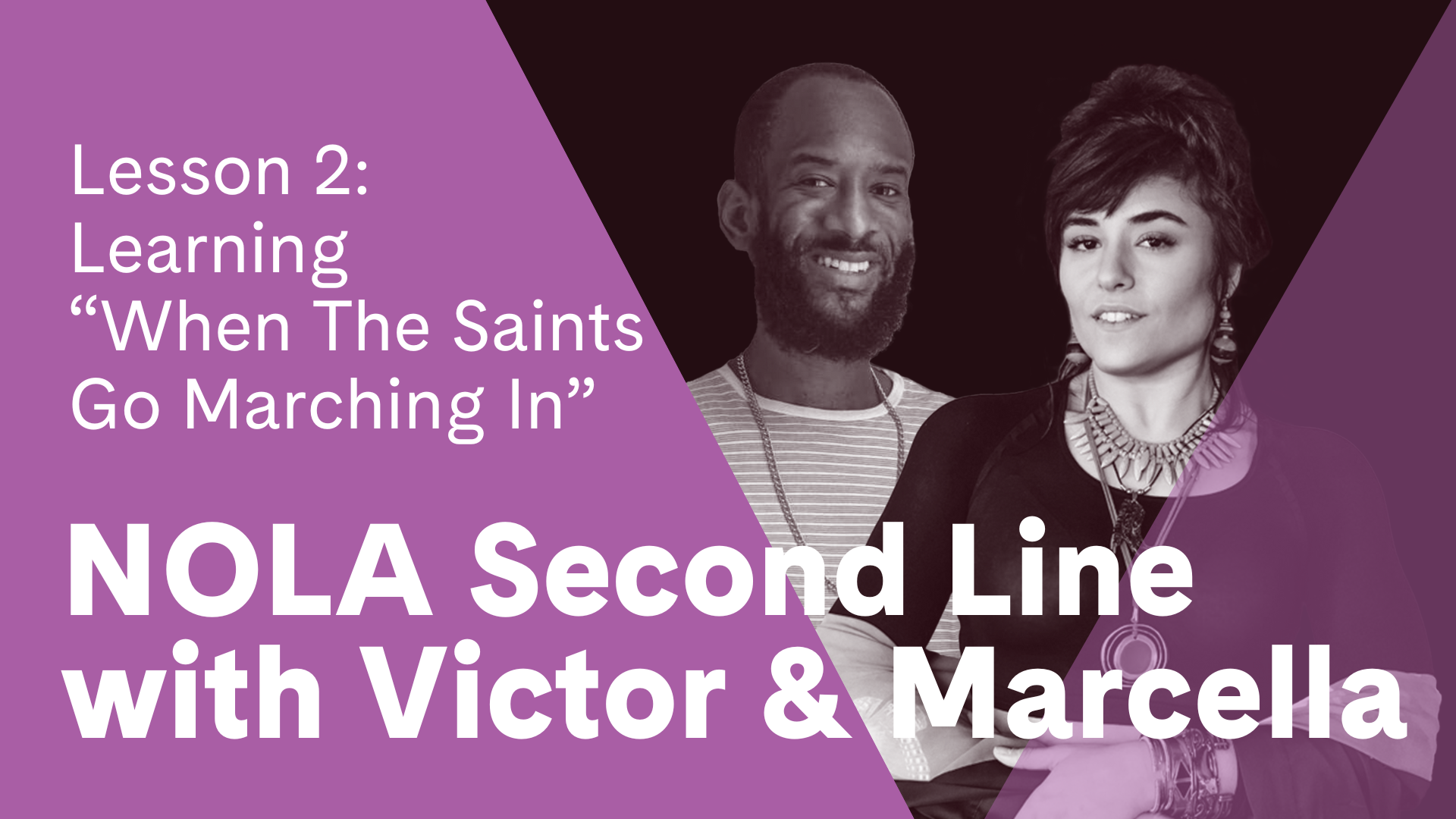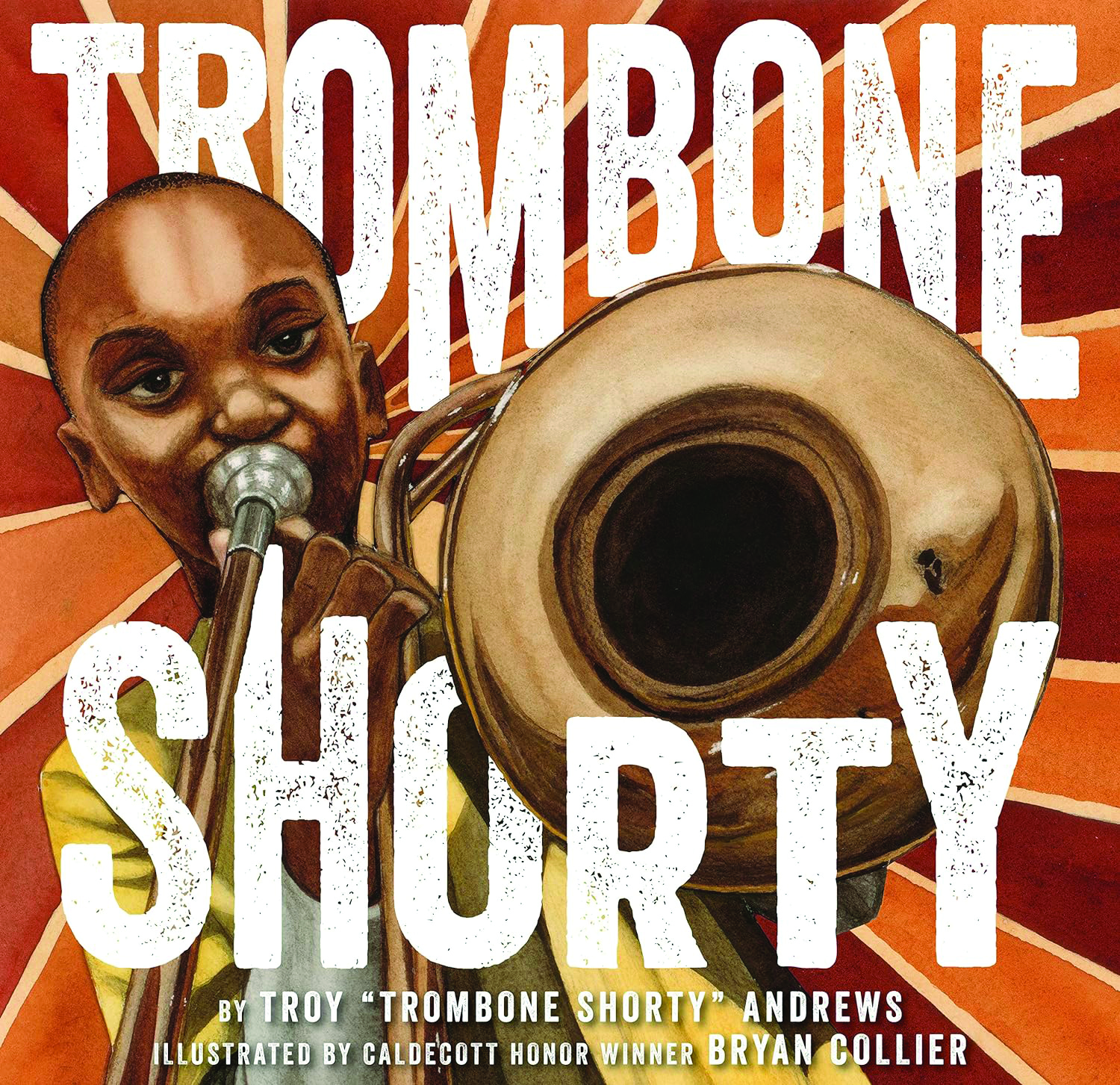Aim: How does a second line band create community?
Summary: Students will learn “When the Saints Go Marching In” and explore the different roles in the second line community.
Materials: Musical Explorers online audio
Standards: GA: MK-2GM.1, MK-2GM.6, MK-2GM.7, MK-2GM.9, MK-2GM.10 SC: GM.PR.NL-AH.3, GM.RE.NL-AH.6, GM.RE.NL-AH.7, GM.CN.NL-AH.8, GM.CN.NL-AH.9
Vocabulary: solo, second line instruments, parade
“When the Saints Go Marching In”
The origin of this song is unknown, but it has roots as a black spiritual and hymn. This song is often played by second line bands when they accompany funerals. This song is used to celebrate memories and the joys of life. Louis Armstrong, who was born in New Orleans, recorded “When the Saints Go Marching In,” in 1938. It is this version that popularized this song and put a spotlight on New Orleans jazz.
Learn “When the Saints Go Marching In”
- Listen to “When the Saints Go Marching In” Track 6.8.
Track 6.8 – “When the Saints Go Marching In” Song
- Sing along to the chorus of using Track 6.9.
- Have you heard this song before? Where have you heard it?
- What do you think this song is about?
- What do you think the mood of this song is? Why do you think that?
- Victor and Marcella think about second line jazz music as a “swirl of sound.”
- Do you agree? What “swirls of sound” are you hearing?
Track 6.9 – “When the Saints Go Marching In” Chorus
“When the Saints Go Marching In”
Oh, when the Saints go marching in,
Oh, when the Saints go marching in,
I want to be in that number,
When the Saints go marching in.
(x2)
Explore the Sousaphone
- Look at SG 42 or display for the class.
- As a class or in small groups, invite students to make predictions about the sousaphone by visuals only.
- What do you think it is made of?
- What shapes do you see? How big do you think it is?
- Does it remind you of anything else?
- How do you think it is played?
- What do you think it might sound like?
- Why do you think this is a special marching band instrument?
- Watch Victor demonstrate how to play the sousaphone below.
Instruments in a Second Line Band
- All instruments are welcome in a second line band, but there are some instruments that are traditionally heard. Using SG 43 look at the image of each second line instrument–the trumpet, snare drum, saxophone, and the sousaphone–while listening to instrument Tracks 6.10 – 6.13 and the sounds that they make.
Track 6.10 – Trumpet Demo
Track 6.11 – Saxophone Demo
Track 6.12 – Sousaphone Demo
Track 6.13 – Snare Demo
Solos and Improvisation in “When the Saints Go Marching In”
- Second line music offers many opportunities for the community and musicians to participate and be included in the performance. How the community responds to the music affects how the band plays.
- Using chorus Track 6.9, practice the call & response in “When the Saints Go Marching In.”
- Can you think of your own or a new way to respond?
Track 6.9 – “When the Saints Go Marching In” Chorus
- When the band is playing, individual instruments can take a solo, or play the melody, or main tune alone. Listen to the song again, Track 6.8, and raise your hand when you think you hear an instrument taking a solo.
Track 6.8 – “When the Saints Go Marching In” Song
Ways to Move in a Second Line Parade
- All are welcome to join a second line parade.
- Visit savannahmusicfestival.org/musicalexplorers to watch some second line parades.
- Using Track 6.8, invite students to march, move, and clap as they listen.
- Refer back to the rhythm layers in lesson 1 to clap along.
- Invite students to create a large move on “big beat 4.”
- If available have students wave handkerchiefs, or tissue paper as they listen.
Creative Extension: Create a Second Line Parade
Traditionally second line parades were started as African-American celebrations that brought the community together. They also were used to celebrate the lives of important community members. As the second line brass band plays, the first line, or persons of honor, carry bright parasols and wave handkerchiefs as they dance. The mood is joyful and the idea is to inspire as many community members to join the parade, in any fashion that feels good–singing, playing an instrument, and dancing are all welcome.
- Let’s explore some ways to create a second line parade. Remember that we are working together to move the parade forward.
- As a class use SG 44 to map out a parade route in your school.
- Decide who will be the person(s) of honor in the first line.
- Create a parade by marching and singing “When the Saints Go Marching In.”
- Students can choose to clap one of the rhythmic layers in lesson 1.
- Invite students to dance by creating a movement on “big beat 4.”
- Include parade props (handkerchiefs, umbrellas, tissue paper, etc.) and instruments as available.
Literacy Link: Trombone Shorty
Trombone Shorty by Troy Andrews and Bryan Collier is the autobiography of Troy “Trombone Shorty” Andrews, who earned his nickname by playing the trombone when he was still half the instrument’s size. Trombone Shorty is an insider’s perspective of the brass band tradition of New Orleans.
Musical Word Wall
Add solo, second line instruments, and parade to the Musical Word Wall.
Audio Tracks
Track 6.8 – “When the Saints Go Marching In” Song
Track 6.9 – “When the Saints Go Marching In” Chorus
Track 6.10 – Trumpet Demo
Track 6.11 – Saxophone Demo
Track 6.12 – Sousaphone Demo
Track 6.13 – Snare Demo
Next: Concert Experience: Spring →


